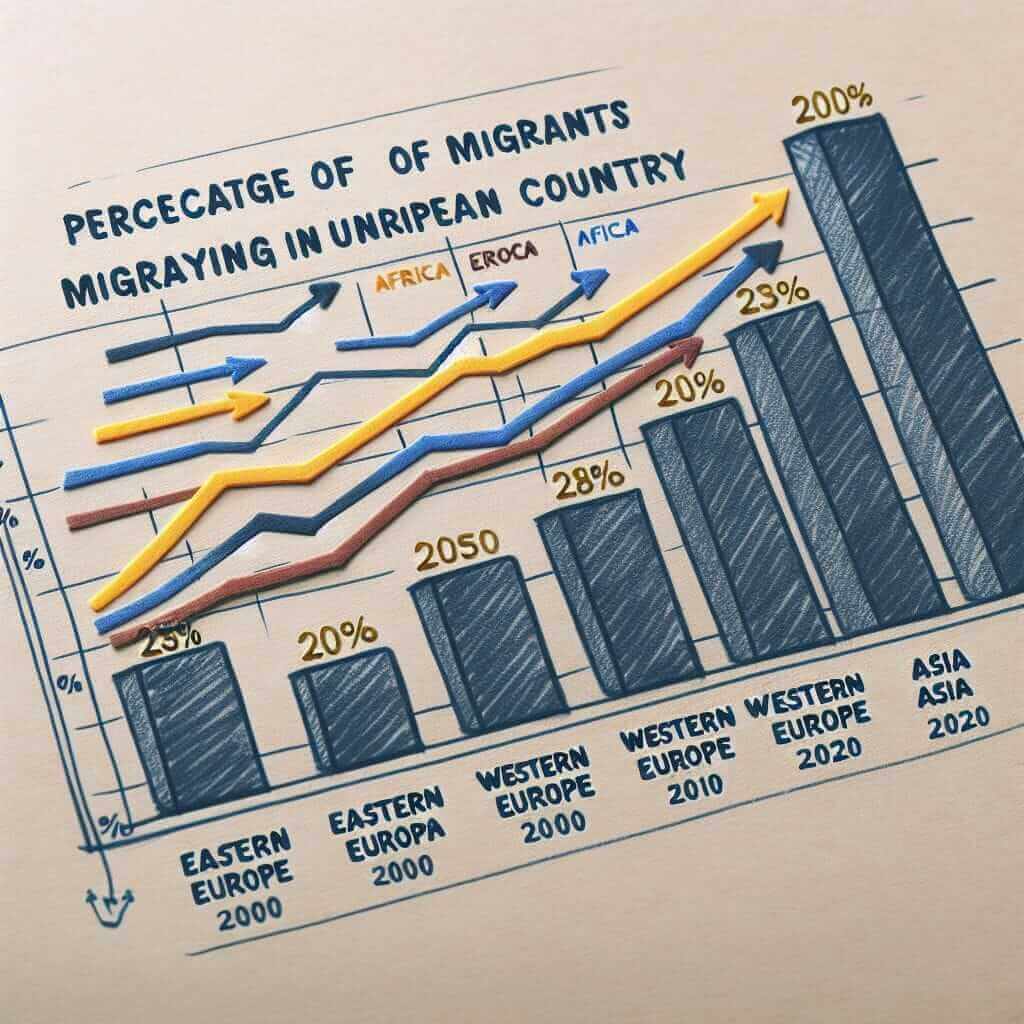The IELTS Writing Task 1 often presents data in various forms, requiring test-takers to analyze and summarize the information effectively. “Migration Patterns in Europe” is a topic that has appeared frequently in recent IELTS exams. This theme explores the movement of people within and into Europe, encompassing various factors like economic opportunities, political situations, and social changes.
Understanding this topic can be beneficial for your IELTS preparation for a few reasons:
- Relevance: It’s a current and globally significant issue, showcasing your awareness of world affairs.
- Data Interpretation: Migration data often involves analyzing trends, comparisons, and making deductions – key skills assessed in Task 1.
- Vocabulary Enhancement: You’ll encounter specialized vocabulary related to demographics, economics, and social issues, boosting your lexical resource score.
Sample IELTS Writing Task 1 Question:
You should spend about 20 minutes on this task.
The chart below shows the percentage of migrants from different regions living in a European country between 2000 and 2020.
Summarize the information by selecting and reporting the main features, and make comparisons where relevant.
(Insert a relevant bar chart showing the percentage of migrants from different regions (e.g., Eastern Europe, Western Europe, Africa, Asia, etc.) living in a specific European country over the years 2000, 2010, and 2020. Data can be hypothetical but should reflect realistic migration trends).

Analyzing the Task
Before diving into writing, let’s break down the task:
- Chart Type: We’re dealing with a bar chart, which visually represents data using rectangular bars of different heights or lengths.
- Key Information: The chart presents the percentage of migrants from various regions residing in a specific European country.
- Time Period: The data spans two decades, from 2000 to 2020, allowing for trend analysis.
- Task Requirements: We need to identify and report the most significant trends, making sure to compare different migrant groups.
Model Answer:
The bar chart illustrates the changing proportions of migrants from different regions residing in (Name of European Country) over a twenty-year period, from 2000 to 2020.
Overall, the percentage of migrants from Eastern Europe experienced the most substantial growth over the two decades. Conversely, the proportion of migrants from Western Europe showed a consistent decline throughout the period.
In 2000, Western Europeans constituted the largest migrant group, comprising 40% of the total migrant population in (Name of European Country). However, this figure decreased steadily to 25% in 2010 and further down to 15% by 2020.
In contrast, the percentage of Eastern European migrants witnessed a dramatic increase. In 2000, they made up only 10% of the total migrant population. This number more than doubled to 25% in 2010 and surged to 45% by 2020, becoming the dominant migrant group.
Migrants from other regions, including Asia and Africa, remained relatively stable throughout the period, fluctuating between 10% and 15%.
(Word Count: 169 words)
Writing Tips for Migration-Related IELTS Tasks:
- Paraphrasing: Avoid directly copying words from the question. For instance, instead of “the chart shows,” use phrases like “the bar chart illustrates” or “the data presents.”
- Trend Identification: Focus on the most significant changes – increases, decreases, fluctuations, or stable patterns. Use appropriate vocabulary to describe these trends (e.g., “sharp increase,” “gradual decline,” “remained stable”).
- Comparisons: Highlight key differences and similarities between different migrant groups. Use comparative and superlative adjectives effectively (e.g., “larger,” “smaller,” “the most significant”).
- Data Accuracy: Report the data accurately and pay close attention to units (percentages in this case).
- Grammar and Vocabulary: Use a range of grammatical structures and appropriate vocabulary related to migration, demographics, and social change.
Key Vocabulary:
- Migrant: (noun) /ˈmaɪɡrənt/ – A person who moves from one place to another, especially to find work or better living conditions.
- Migration: (noun) /maɪˈɡreɪʃən/ – The movement of people from one place to another.
- Influx: (noun) /ˈɪnflʌks/ – A large number of people or things arriving at the same time.
- Emigration: (noun) /ˌemɪˈɡreɪʃən/ – The act of leaving one’s country to live in another.
- Immigration: (noun) /ˌɪmɪˈɡreɪʃən/ – The action of coming to live permanently in a foreign country.
- Push Factors: (noun phrase) – Negative aspects of a person’s current location that encourage them to migrate.
- Pull Factors: (noun phrase) – Positive aspects of a potential destination that attract migrants.
- Demographics: (noun) /ˌdeməˈɡræfɪks/ – Statistical data relating to the population and particular groups within it.
Conclusion:
By understanding common IELTS themes like “Migration Patterns in Europe” and practicing data interpretation, you’ll be better equipped to achieve your desired band score. Remember to analyze the task carefully, use appropriate vocabulary, and present the information cohesively and accurately.